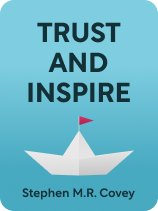

This article is an excerpt from the Shortform book guide to "Trust and Inspire" by Stephen M.R. Covey. Shortform has the world's best summaries and analyses of books you should be reading.
Like this article? Sign up for a free trial here.
Do you believe in the people you lead? How do you prove it? What difference does your trust make in them and your mission?
Stephen M. R. Covey says that inspirational leaders extend faith to people. Extending faith means not only seeing that everyone has a higher potential but also believing that they can achieve it. Extending faith also requires leaders to give employees autonomy rather than micromanaging.
Read more to get Covey’s insights on leading with trust.
How to Lead With Trust
Covey argues that extending faith to employees is important because it allows them to reach their full potential and maximize performance. Expressing your belief in someone’s abilities to perform at a high level, and granting them autonomy to do so on their own, inspires them to meet—and even exceed—your expectations. Further, leading with trust is contagious: Your choice to believe in others will gradually ripple outward, increasing collaboration and strengthening relationships throughout the organization.
| Enable Employees Through Trust, Autonomy, Tension, and Interdependency Covey argues that you must enable employees to reach their full potential by extending trust and autonomy to them. In their article on Complexity Leadership Theory, Mary Uhl-Bien, Russ Marion, and Bill McKelvey reiterate this claim; however, their process for enabling employees is more dynamic than Covey’s. First, the authors agree that granting employees trust and autonomy to complete tasks and solve problems inspires them to reach a higher creative potential. However, they add that to truly catalyze employee development, you must create tension that challenges them. On a local level, you can create tension by having employees work in groups with diverse opinions, perspectives, and experiences. Challenging them to figure out problems on their own, with no intervening authority, will teach them to differentiate between interpersonal conflicts and task conflicts. On a global level, you can create tension by judiciously supplying resources or information to employees. This permits them to explore pathways that challenge them to enhance their learning and creativity. Second, while Covey argues that having confidence in employees will inspire them to have confidence in and collaborate with others, these researchers recommend more targeted methods to encourage this phenomenon (what they call interdependency). On a local level, one way to do so is to promote informal interactions in which employees form connections (the well-being of one becomes linked with the well-being of another) and where they can share information and learn from each other. On a global level, organizations can promote interdependency by creating rules that require employees to work together—for example, having a group get feedback from another group rather than the leader. |
Covey says that effectively extending faith relies on two foundations: setting clear expectations and practicing accountability.
Foundation #1: Set Specific, Mutually Agreed-Upon Expectations
Covey explains that employees can only meet your expectations if you’re specific about what they are. Otherwise, misunderstandings are likely to arise and both parties may end up disappointed.
To ensure a positive outcome, first, nail down specifics—what does “success” or completion of the task look like? What are the deadlines? What resources are available?
Then, discuss these expectations with employees and come to a mutual agreement. Genuinely consider any amendments employees may want to make. For example, if you want a task to be completed by Monday but the employee thinks Wednesday is better, accept the request as long as there are no major issues with it. Mutually agreeing on expectations provides employees with a sense of meaning behind their work—they’re doing things because those things are important and make sense, not just because you said so.
| Set Expectations That Enhance, Rather Than Stifle, Creativity Complexity Leadership Theory researchers warn that there’s a fine line between expectations that enhance creativity and those that stifle it. To set expectations that enhance creativity, create a general “mission” rather than establishing all details immediately. Creating a firm definition of “success,” as Covey recommends, can inhibit creativity and innovation, both of which thrive in environments of uncertainty. For example, your goal could be to “create an improved system by October 30.” Rather than specifying up front how this mission should be accomplished, what the exact outcome will be, and the resources available to do so, these details should be left open to change, as circumstances will change throughout the process. While CLT doesn’t mention creating mutually agreed-upon expectations, Covey’s recommendation for discourse between leaders and employees seems to be a crucial component to ensure adaptability throughout the process. |
Foundation #2: Create an Accountability Plan
To ensure expectations are met, Covey says you must hold others accountable for progress and results. It’s unrealistic to tell someone what you want and expect that it will be perfect without checking in throughout the process. If things veer off track or an employee needs help, you want to be available to provide guidance.
Further, Covey emphasizes mutually agreeing upon accountability methods. Your methods of practicing accountability may compromise your extension of faith if the employee feels micromanaged. To avoid this outcome, co-create an accountability plan with the employee to instill a sense of autonomy and accountability.
| CLT Balances Accountability With Autonomy Complexity Leadership Theory researchers agree that leaders must ensure accountability without micromanaging by periodically checking in with employees. However, their methods differ from Covey’s in a couple of ways. First, they don’t discuss creating mutually agreed-upon accountability plans—their concept of ensuring accountability is more informal. To do so, they recommend periodically checking on progress in relation to the mission—for example, what benchmarks should be met at a given point relative to the scope and deadline of the project? Further, rather than warning employees if they veer off track or providing guidance, CLT asserts that leaders should remind employees of the project’s mission and offer technical support. Doing so refocuses employees on the goal without interfering with any creative or innovative path they may be taking. Once they’re refocused, they can decide for themselves if they need to change their methods. |

———End of Preview———
Like what you just read? Read the rest of the world's best book summary and analysis of Stephen M.R. Covey's "Trust and Inspire" at Shortform.
Here's what you'll find in our full Trust and Inspire summary:
- How to inspire employees to maximize their work quality using trust
- The five doctrines inspirational leaders believe in
- The three commitments you must adopt to become an inspirational leader






